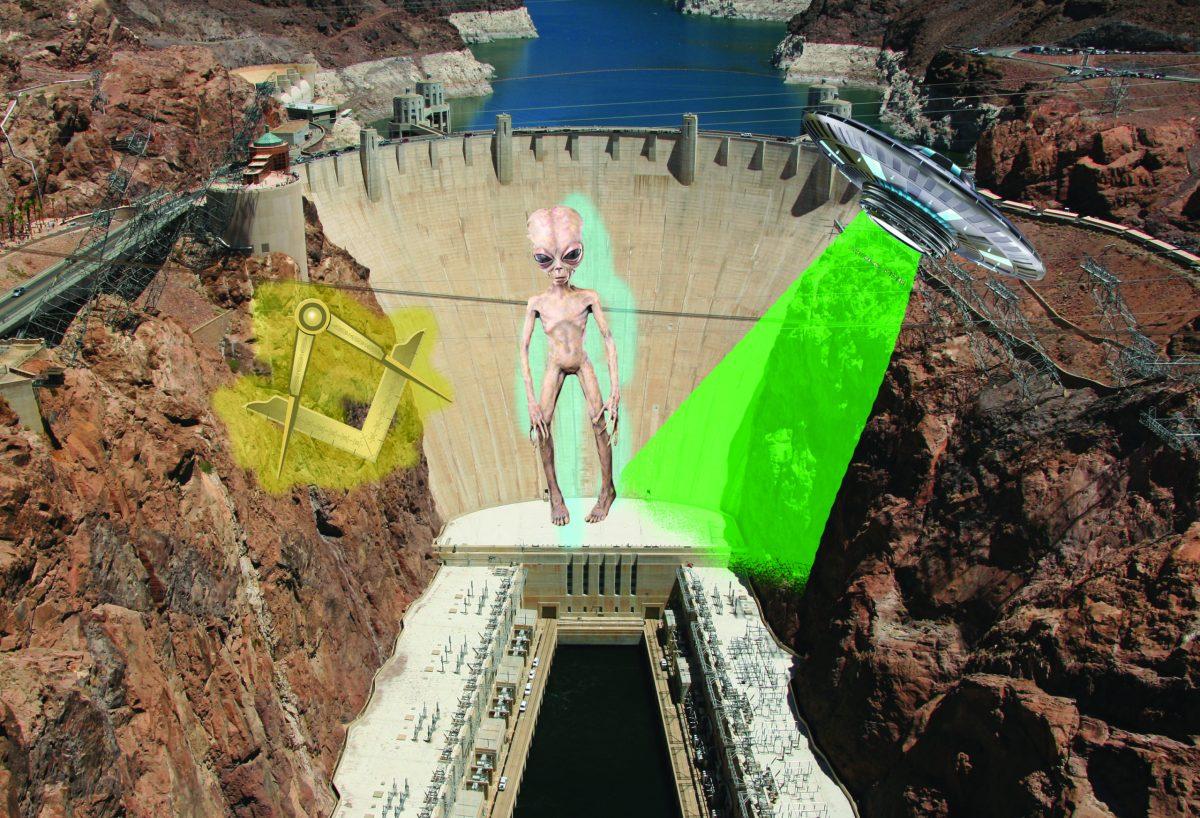If you’ve never visited the Hoover Dam, allow me to describe for you its permeating endorsement of the occult.
Garbled green angel statues with angry faces strike vertical wings skyward. Meanwhile, a large bronze zodiac hints at perhaps supernatural motivations. Many of the symbols are buffed and gleaming from the number of tourists who have grazed them for luck. A staff stretches skyward with a golden orb attached, symbolizing the sun’s location on the day of the dam’s completion, almost like a beacon. Art deco ornamentation, captivating in its simple fractal geometry, could easily function as summoning circles or other demonic symbology. Elevators on the dam apparently descend into its belly, but (perhaps due to the pandemic) none were open to the public on the day of my visit. Something is inside the dam, out of the public’s direct eye. Who is to say that something is not alive?
The oddest thing about the ominous Hoover Dam, which should be ripe for public speculation, is that there exist no mainstream conspiracy theories about it outside of clickbait listicles – articles which mostly relate to mid-20th century safety standards for construction workers. The closest Google results are unglamorous news articles about a QAnon domestic terrorist holding up the nearby Mike O’Callaghan–Pat Tillman Memorial Bridge, radicalized by a conspiracy theory unrelated to the dam itself. Somehow, even the QAnon wackos have failed to conceptualize charisma for it.
Though it is only approximately 150 miles from the apparent site of Area 51 (Google Maps doesn’t offer an exact driving route or distance), you will find no speculation that the dam is the real holding site for the aliens, nor that Area 51 is a front to misdirect truthers. You will find no arguments that the orb-on-rod apparatus communicates with extraterrestrials. You will find no theories that the government is using the Hoover Dam to summon Samarian devils for sacrifice of unborn babies in exchange for stem cells. You will find no postulation that the angels are robots that can come to life and defend America in the event of a credible nuclear threat. I’m apparently the first person to consider any of this.
How the Hoover Dam’s popularity among suburban Christian women survived the Satanic moral panics of the 60s, 70s, 80s and 90s, I may never know. How it has failed to become a pilgrimage site for Wicca, pagans and Scientologists also eludes.
Americans have never been particularly generous toward our infrastructure in the past. Searching “Denver Airport conspiracy theory” yields 877,000 Google results, including those from mainstream outlets like Travel and Leisure and even the Denver Post. There exist countless supernatural conspiracy theories far more mainstream – and far more convoluted and anti-Semitic – than what I propose about the Hoover Dam. America knows no better way to immortalize something than to turn against it. Barring “Men in Black”-style memory wiping, the only explanation for sparing the Hoover Dam from this radicalization-by-proxy is that Americans simply cannot be bothered to care much about it.
Oh, Hoover Dam. How we have forsaken you.
The arcane aside, Hoover Dam is a perplexing point on America’s tourism landscape. For a place that attracts 7 million tourists annually – almost as many as the 8.7 million Americans who travel to the Caribbean in a non-pandemic year – Hoover Dam never seems to make it into the vacation highlight reels. Despite the apparent pertinence of the dam, I’ve heard few conversations about it. Americans somehow possess the dissonance to both understand the Hoover Dam as a destination, and yet to siphon all memory of it from consciousness the instant their car exits the parking lot.
Hoover Dam is a liminal space. Hoover Dam is a contradiction. Hoover Dam is chaotic. Hoover Dam is us, America.
Maybe it is my perspective as a young person that has allowed my imagination for the Hoover Dam to run wild. Perhaps it is only as a girl who grew up only knowing a post-9/11 country hellbent on gutting its soul in the name of austerity, that that I find myself enamored with the Hoover Dam. To other countries, it may just be another mass of functional concrete. But in America, the Hoover Dam is an anomaly, a relic of a time when the political faction of White Protestant America still maintained the façade of improving life for its constituents.
I am disinclined to travel during a pandemic, but had rationalized my trip through the lens of education: I was completing a field camp with other (masked) geology students from all over the country, mapping the results of millions of years of crustal thinning and extension in the western United States. I am also disinclined to Americana as to make a tourist destination out of our national infrastructure. But it was an off day for my field camp, and I was, after all, in Mohave County, Arizona. (When Americans are in Mohave County, Arizona – pandemic or not – we see the Hoover Dam. It’s just what we do.)
For a group of mostly Gen-Z college students, it is strange that the Hoover Dam is not ugly in the crude and utilitarian way so typical of our emaciated government programs. It is strange that it is not gaudy, either, dripping with the excesses of a culture bloated on aesthetics but starving for values. It is strange to us young people that the Hoover Dam is, in its own way, beautiful.
The walkways are paved, but the rock face along them is bare. You can reach out and touch them, and feel the slickenlines, polished directional features remnants of slip faulting; you can see clearer faulting if you look down along the sides of the river. Here’s what I know about the geology: America has always been breaking and shifting. 21st century institutional rot has just stifled any potential for us to muscle through it.
There is much about Hoover Dam that stands in contrast to modern politics’ simple, gleeful destruction of anything good.
What’s the Hoover Dam hiding? That was my question, as I stood on that towering spindle straddling Arizona and Nevada, bridling Lake Mead into the electricity that heats the morning coffee for 1.3 million people before dumping it right back out into the Colorado River.
I wanted to know: What is the Hoover Dam not telling us?
I needed to know: Why would something as good as this exist here, if it doesn’t accomplish something evil along the way? I dove into the possibilities.
Here’s one more detail about the dam. Frescoes homage the pre-industrial landscape, its biodiversity, its farmland, its Native tribes who were stewards for the land long before there existed a Bureau of Reclamation to even build a dam. There is no homage to what happened to those peoples. Hoover Dam leaves it to American mythology to fill in the gaps.
For comments/questions about this story, email [email protected] or tweet @TheWhitOnline.
























































































































































!["Working with [Dr. Lynch] is always a learning experience for me. She is a treasure,” said Thomas. - Staff Writer / Kacie Scibilia](https://thewhitonline.com/wp-content/uploads/2025/04/choir-1-1200x694.jpg)









































